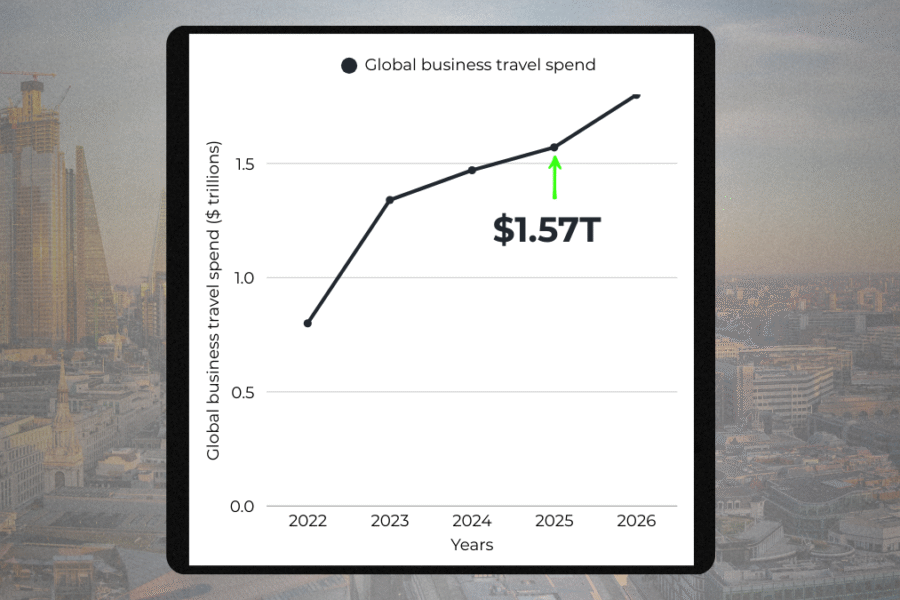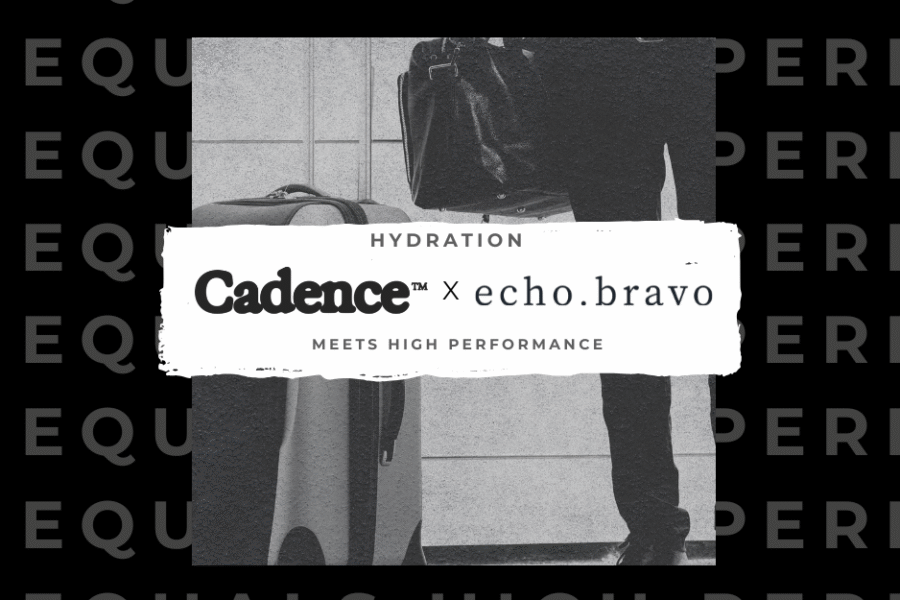We track how people interact with our online web content and resources, and some of that tracking involves storing cookies on your device. By continuing to use our site you accept that you agree to this. For more details see our Privacy Statement.
Business Travel Performance: why showing up isn’t enough anymore
29 September 2025 | Business Travel Performance
This is our flag in the sand. Business Travel Performance is the operating standard for leaders who travel. Not motivation. Not vibes. Inputs that protect outcomes, Hydration, Nutrition, Wellness, Confidence, so you arrive switched on and win the room.
On this page
- What we mean by Business Travel Performance (definition & scope)
- Market reality: why Business Travel Performance matters commercially
- The human factors behind Business Travel Performance (hydration, circadian, cognition)
- The four pillars as strategy, not “wellness”
- The boardroom case: risk, ROI and decision quality
- Is “economy” a false economy?
- Partnered for performance: echo.bravo × Cadence
- Conclusion: setting a new standard for Business Travel Performance
- FAQ
What we mean by Business Travel Performance (definition & scope)
“Performance” is how well a person does a piece of work or an activity. That’s the test: not attendance, outcome quality under pressure — Cambridge Dictionary
Business Travel Performance is the consistent ability to make clear decisions and communicate with impact despite the physiological drag of travel. Think in simple model terms: inputs (environment, sleep, hydration, nutrition) → mediators (attention, working memory, mood) → outputs (negotiation quality, clarity, follow-through).
For the full framework and future deep dives, visit our Business Travel Performance hub.
Market reality: why Business Travel Performance matters commercially
Business travel is not a side show; it’s a macro engine. Global spend is projected to reach $1.57 trillion in 2025, a new high in nominal terms, amid policy and economic uncertainty. It’s not just your company travelling, it’s your competitors too, you need an edge.
Pricing outlooks point to stabilisation through 2025–26 rather than dramatic drops. Forecasts suggest modest air-fare movements and hotel ADRs edging up under the base case, meaning cost scrutiny stays high, and every trip must earn its keep.
Beyond simple fare inflation, there’s a hidden cost curve in play. Companies often track flights and hotels, but they rarely factor in the ripple effects of fatigue-driven errors, sick days, or muted follow-through after a trip. In other industries, this is measured carefully: in one study of flight crew, more long-haul and cross-time-zone flights were significantly associated with higher numbers of sick leave episodes. That’s not a direct proxy for executives, but it does suggest the human toll of global travel is measurable, and has financial consequences.

The human factors behind Business Travel Performance (hydration, circadian, cognition)
The immune system is another casualty of misaligned travel. In a prospective study tracking thousands of travellers, each additional day in transit increased the risk of contracting an illness by around 2.5%. Cabin dryness and time zone mismatch don’t just blunt focus, they lower defences. That risk compounds across scaling teams who fly week after week. Protecting Business Travel Performance therefore isn’t a luxury; it’s a shield against lost days, missed meetings, and higher healthcare costs.
Cabin humidity: At cruise, cabins typically sit well below everyday indoor levels, commonly ~10–20% relative humidity on many aircraft, i.e., desert-dry. That’s by design (condensation and corrosion control) but it increases dehydration risk on long sectors.
Dehydration & cognition: Even a ~1–2% body-water loss is associated with decrements in attention, mood and cognitive performance, the exact enemies of high-stakes meetings – Riebl SK & Davy BM, “The Hydration Equation: Update on Water Balance and Cognitive Performance,”
Jet lag: A bona fide circadian mismatch presenting as sleep disturbance, cognitive impairment and daytime sleepiness. Authoritative guidance highlights the functional hit, and why timing of light/sleep/food matters – CDC Yellow book.
Sleep & decision quality: Modern experimental work shows sleep loss changes how leaders decide, less deliberation, altered use of negative feedback, shifts in risk propensity. That’s edge squandered in a pitch.
The four pillars as strategy, not wellness
Hydration. Cabin air can be drier than the Sahara, and when you layer in long meeting days, a predictable fluid deficit builds. Protecting hydration helps preserve attention, working memory and mood when it counts.
Nutrition. The timing and composition of food influence alertness, mood and sleep quality. Even your daily coffee matters: a controlled study found that a 400 mg dose taken six hours before bed still measurably disrupted sleep.
Wellness. Movement, light and sleep are the real tools of circadian control, not spa extras. Evidence-based jet lag strategies show consistent improvements in next-day function for business travellers.
Confidence. Confidence isn’t just a feeling; it’s a set of prepared behaviours, ritual, posture, rehearsal, even the right kit. In a noisy market, composure is a signal your buyers notice. For our team’s own approaches to staying sharp on the road, see Meet the Team.
The boardroom case: risk, ROI and decision quality
Imagine walking into a £6m pitch on three hours of broken red-eye sleep. The fare savings might please procurement, but degraded cognition changes the outcome probability in the room. Experimental data shows losing just one hour of sleep per night for a week can slow performance by 5–9% in complex tasks. That drag is invisible on the P&L, until the deal slips. For leadership teams, tightening pre-trip and in-trip behaviours is therefore a low-cost form of risk control: more than “wellness,” it’s commercial insurance.
Outcome ROI > travel ROI. Finance teams often track spend per trip, but boards care about return per decision. Protecting cognition under travel stress directly raises the probability of a good outcome. See our Business Travel Performance hub for the wider framework.
Risk control. Sleep restriction and circadian misalignment don’t just make you tired, they change how information is processed and feedback is used in decision-making. Tightening pre-trip and in-trip behaviours is a low-cost form of risk management.
Talent signal. High performers want to win and stay healthy. A clear travel-performance standard tells them, “we take your brain seriously,” which strengthens recruitment and retention.
Client trust. Walking into a meeting composed after a red-eye isn’t just personal discipline; it’s a brand statement. Clients notice, and they buy confidence as much as capability.
“Business Travel Performance isn’t about how you feel on the road, it’s about how well you deliver when the stakes are highest.”
— Chris Donovan, Founder, echo.bravo
Is “economy” a false economy?
If an upright seat cuts meaningful sleep, and even partial sleep restriction nudges decisions toward poorer information use and riskier choices, then any fare saving can be wiped out by a lower win-rate or slower follow-through on a six-figure deal.
Where travellers can actually sleep on board (true lie-flat), field data in elite cohorts show in-flight sleep bouts of around 4.7 hours with ~87% efficiency, and better in-flight sleep aligning with lower fatigue in competition. Different population, same mechanism: more real sleep → better next-day function.
Newer wide-body aircraft such as the Boeing 787 Dreamliner and Airbus A350 help further by enabling lower cabin altitudes (~6,000 ft) and higher humidity than older types, which many travellers report as less fatiguing — a structural nudge in the right direction.
The “cheap seat, costly outcome” paradox is more than rhetoric. Among professional pilots, even with training and resilience protocols, surveys show an average of 6.8 days of sick leave and 1.2 days of fatigue leave per year. If that’s the toll on those conditioned to fly, what’s the effect on deal-makers with no circadian mitigation training? Business class and premium economy aren’t perks in that light; they’re tools to protect ROI. For boards chasing marginal gains, class of travel becomes a strategic lever, not a perk to cut.
Bottom line: Cheap seats can yield expensive outcomes. For a deeper dive into the economics of travel choices, explore our managed business travel services.
Partnered for performance: echo.bravo × Cadence

Hydration is the foundation of Business Travel Performance. That’s why echo.bravo has partnered exclusively with Cadence, the hydration specialists trusted by elite athletes and high performers. Their products are designed to maintain fluid balance, electrolytes and focus in demanding environments. For business travellers, that translates to clearer thinking, better mood, and stronger decision-making on the road.
- Hydration systems built for sustained attention and recovery
- Electrolyte balance that supports cognition under dry cabin conditions
- Performance-led products adapted from elite sport into business travel
As an EB member, you’ll also unlock exclusive perks and preferred access with Cadence, part of our commitment to bringing the very best performance tools into business travel.
Explore our exclusive partnership with Cadence here
Conclusion: setting a new standard for Business Travel Performance
The stakes are high, $1.57 trillion high, and the human tax is real: dry cabins, circadian mismatch, decision drift. Business Travel Performance names the problem and sets the standard. The how posts will follow; the why is settled. — GBTA
No middle seat energy.
We choose the aisle seat, the clear head, the win.
For the full framework and deep dives into hydration, nutrition, wellness and confidence, start with our Business Travel Performance hub. Or, if you’re ready to take the next step and join a curated circle of high performers, apply for membership.
FAQ
Why does Business Travel Performance matter commercially?
Because the cost of business travel isn’t just in tickets and hotels, it’s in outcomes. Research shows that even mild dehydration or circadian misalignment can impair memory, attention and decision-making. For organisations competing on high-stakes deals, that translates into real financial risk. Business Travel Performance reframes travel from an expense line into a performance driver: protecting cognition, preserving mood, and increasing the chance of a win. For a detailed breakdown, see our Business Travel Performance hub.
Is Business Travel Performance just another word for wellness?
No. Wellness is about how good you feel. Business Travel Performance is about how well you deliver under pressure. It’s a form of operational risk management and ROI protection: better hydration, nutrition, sleep and confidence lead to better presentations, negotiations and strategic calls. In other words, it’s not about yoga in hotel rooms, it’s about ensuring your team make sharp, profitable decisions on the road. Learn more in our insights blog.
Do newer aircraft like the Boeing 787 or Airbus A350 really make a difference?
Yes. Modern wide-body aircraft such as the Boeing 787 Dreamliner and Airbus A350 are pressurised to a lower cabin altitude (around 6,000 ft vs 8,000 ft on older models) and allow higher humidity levels. Many travellers report arriving less fatigued and better able to function the next day. For companies focused on Business Travel Performance, route selection and aircraft type become part of the ROI equation. It’s another example of how small choices can scale into commercial outcomes.
Can travel increase the risk of sick days?
Evidence suggests yes. In a study of airline crew, more long-haul and time-zone crossings were linked to higher rates of sickness absence. In broader traveller studies, each extra day on the road raised the risk of catching an illness by ~2.5%. Extrapolated to business travel, this implies that unmanaged schedules and poor recovery protocols may quietly inflate absenteeism costs.
About the author
Chris Donovan is the founder of echo.bravo, a UK business-travel firm serving scaling teams and venture-backed brands. With over a decade in the industry, he writes about Business Travel Performance, modern TMC strategy, and the future of work-through-travel. His perspective blends founder experience, operational insight and a human-first approach to travel performance.
Updated: 29 September 2025.